Like stepping into a Western film, you’ll find Yuma’s sun-baked streets and riverfront trails full of stories waiting to unfold. You can wander a real territorial prison, paddle calm river bends at sunrise, climb golden dunes, or savor Sonoran-style breakfasts downtown. This list will guide you through historic sites, outdoor adventures, food and festivals — and help you pick the perfect mix for your visit.
Yuma Territorial Prison State Historic Park
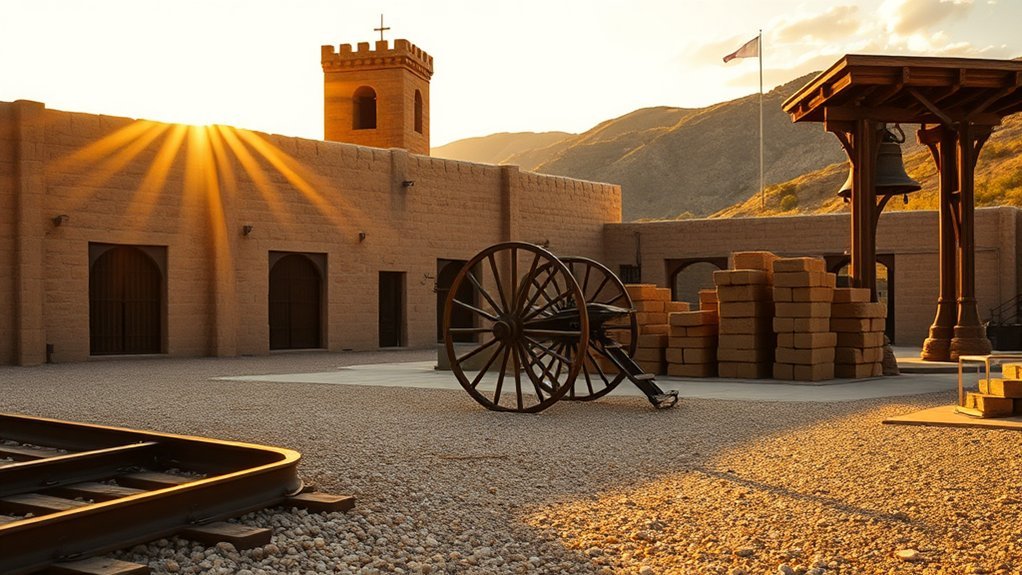
If you venture to Yuma Territorial Prison State Historic Park, you’ll step into the stark, fascinating world of 19th-century frontier incarceration. You’ll walk gravel pathways between low stone cellblocks, run your fingers along weathered walls, and imagine the dry Arizona sun pressing through narrow slits. Exhibits display original cell doors, artifacts, and inmate records that reveal daily routines, punishments, and the harsh realities of desert confinement. You’ll climb to the guard tower for wide views of the Colorado River and the surrounding plains, sensing why this site was both remote and secure. Interpretive signs and costumed docents share stories of notable prisoners, escapes, and the prison’s role in regional law enforcement. Photography’s allowed, so you can capture the stark architecture and evocative atmosphere. Plan for an hour or two, wear comfortable shoes, and bring water—the park’s compact layout makes it easy to explore while leaving you with a vivid sense of Yuma’s frontier past.
Yuma Crossing National Heritage Area
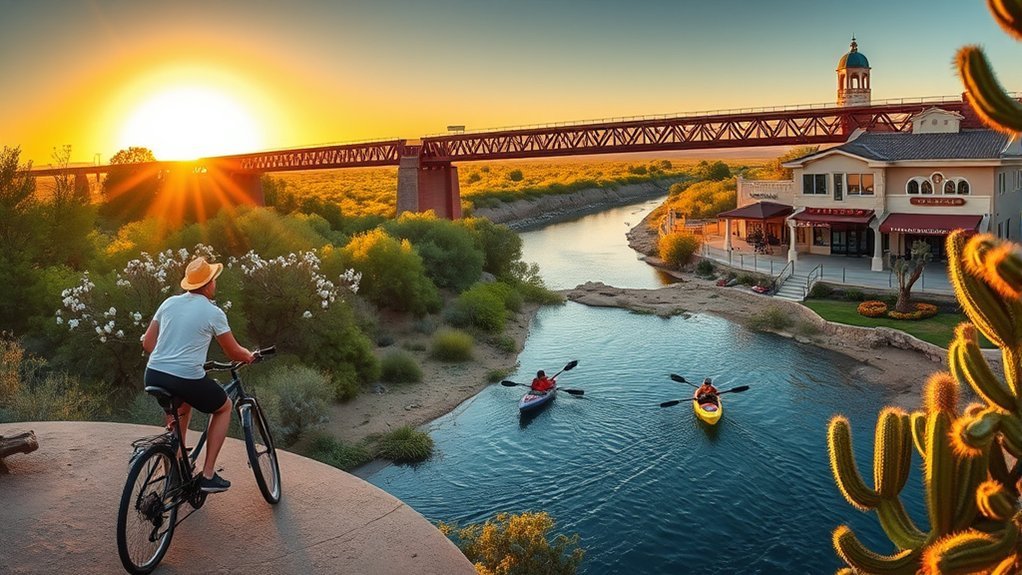
Bordering the Colorado River and the historic quarter of downtown, Yuma Crossing National Heritage Area brings together cultural landmarks, riverfront parks, and interpretive trails that trace the city’s role as a gateway between Arizona and California. You can stroll the levee-top paths for sweeping river views, watch kayakers slip past cottonwood-lined banks, and read informative panels that explain steamboat traffic, immigrant trails, and the development of irrigation that shaped the region. The restored Yuma Crossing plaza and pedestrian-friendly bridges connect museums, cafés, and seasonal events, so you’ll find history woven into everyday life. Look for guided walks and interpretive programs led by local historians; they’ll add context to the markers and photos you’ll encounter. Birdwatchers will appreciate riparian habitat teeming with migrants, while photographers will love sunrise light on the bridges and historic brick buildings. Whether you want a relaxed afternoon by the water or a focused historical walk, Yuma Crossing offers thoughtful, accessible ways to experience the city’s riverfront heritage.
Fort Yuma Museum
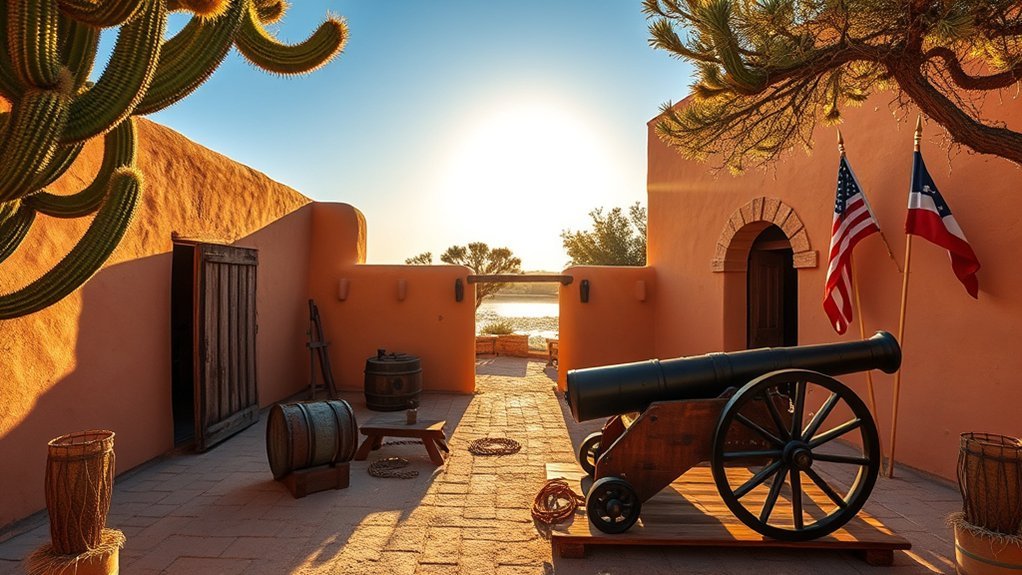
Step into Fort Yuma Museum and you’ll find a compact, well-curated glimpse of military life on the 19th‑century frontier. You’ll move through rooms filled with uniforms, weapons, photographs and personal items that tell stories of soldiers, settlers and Native American interactions. The exhibits explain how the fort guarded the river crossing, supported regional communication and shaped Yuma’s early growth. You can read firsthand accounts, study maps showing troop movements and inspect restored artifacts that convey daily routines—meals, drills and camp life. Docents are typically on hand to answer questions and point out small but telling details you might miss on your own. If you’re interested in regional history, the museum’s interpretive panels and archival displays give clear, concise context without overwhelming you. Plan for a focused 30–45 minute visit, then linger if a particular display captures your attention. The museum’s compact scale makes it easy to appreciate history up close.
Colorado River State Historic Park
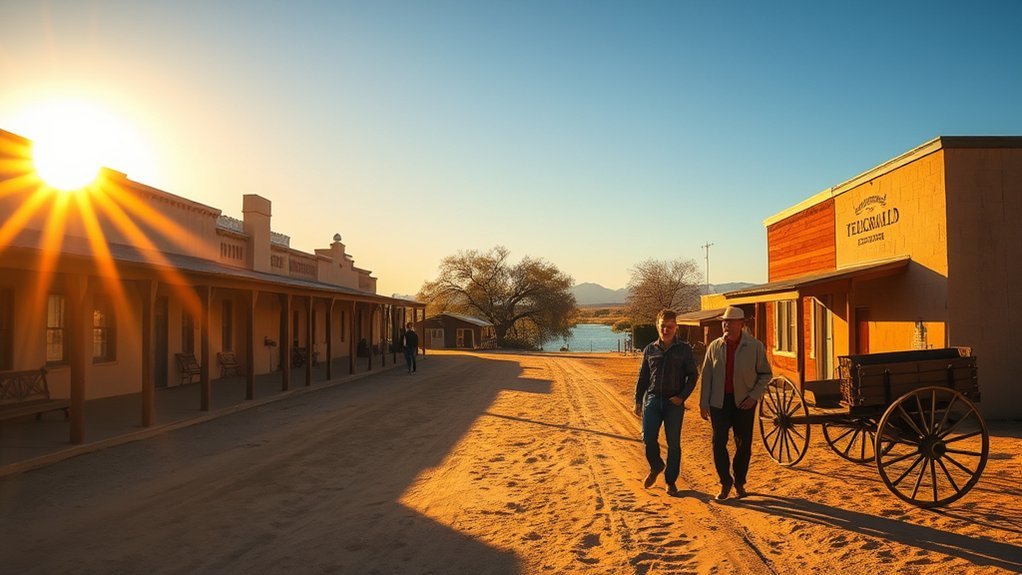
At Colorado River State Historic Park you can explore the restored Yuma Quartermaster Depot and imagine life when the river was the town’s lifeline. Walk the riverfront trails for wide water views and birdwatching, then catch a living history program to see period demonstrations and hear first-hand stories. It’s a compact, hands-on spot that brings Yuma’s riverfront past to life.
Historic Yuma Quartermaster Depot
When you walk into the Historic Yuma Quartermaster Depot at Colorado River State Historic Park, you’ll step into the 19th-century military logistics hub that helped supply forts across the Southwest. You can explore restored adobe warehouses, officers’ quarters, and the commissary while imagining mule trains and steamboats unloading goods. Exhibits explain supply chains, military life, and Yuma’s role as a transportation nexus. Docents often share anecdotes about riverine commerce and regional conflicts, making history vivid without feeling dry. Audio-visual displays and artifacts — maps, rifles, uniforms, trunks — give context to daily operations. You’ll leave with a clear sense of how this depot shaped settlement, defense, and commerce in the arid frontier surrounding the Colorado River.
Riverfront Trails & Views
Bordering the historic depot, the riverfront trails invite you to stroll, bike, or pause and watch the Colorado River glinting under the desert sun. The paved path follows the water’s edge, offering wide views of cottonwood-lined banks, paddlecraft launching, and migrating birds that dot the skyline. Interpretive signs point out steamboat history and local ecology, so you’ll learn as you move. Benches and shaded spots make it easy to rest and photograph rippling reflections or the distant Gila Mountains. Early mornings bring cool air and wildlife activity; evenings deliver striking sunsets and cooler breezes. The trail connects to nearby parks and downtown Yuma, letting you extend your outing into cafés, galleries, or a relaxed riverside picnic.
Living History Programs
If you want history that feels alive, the Colorado River State Historic Park’s living history programs put you right into Yuma’s riverfront past. You’ll meet costumed interpreters who recreate 19th-century river life—soldiers, steamboat crews, traders—and you’ll hear firsthand about irrigation, trade, and frontier challenges. Interactive demonstrations show period tools, blacksmithing, and adobe construction, so you can see how people built homes and harnessed the river. Guided tours explain the site’s role in regional growth, and special events spotlight seasonal activities and children’s programs that make history tangible. You can ask questions, handle replica artifacts, and photograph authentic scenes. Whether you’re a history buff or casual visitor, these programs make Yuma’s story memorable and immediate.
Imperial Sand Dunes Recreation Area
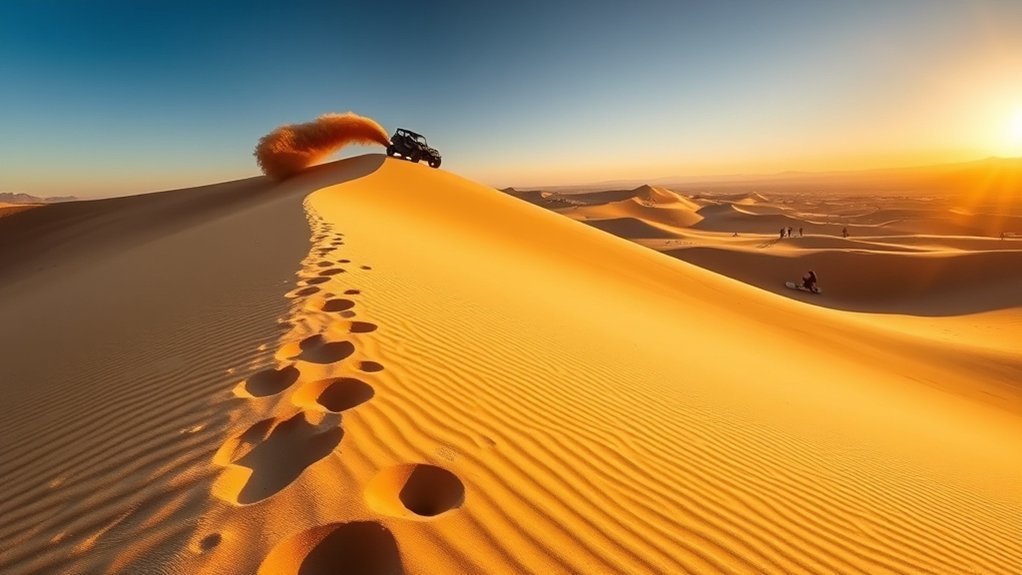
Stretch out across more than 40 miles of wind-sculpted dunes, the Imperial Sand Dunes Recreation Area (often called Glamis) offers one of Southern California and Arizona’s most dramatic desert playgrounds just a short drive from Yuma. You’ll find shifting golden ridges, wide open vistas, and a sense of scale that makes you feel small in the best way. Whether you want high-speed thrills or quiet exploration, the dunes deliver.
- Rent ATVs or sand rails for heart-pounding runs up and down steep faces.
- Hike to quieter dune fields at sunrise or sunset for cooler temperatures and softer light.
- Try sandboarding for a fast, accessible way to surf the slopes on a board.
- Photograph wildlife and wind patterns — the constantly changing shapes are a photographer’s dream.
Bring plenty of water, sun protection, and a vehicle suited for soft sand. Respect designated riding zones and leave no trace to preserve this fragile, spectacular landscape.
Gateway Park and Riverfront Trails
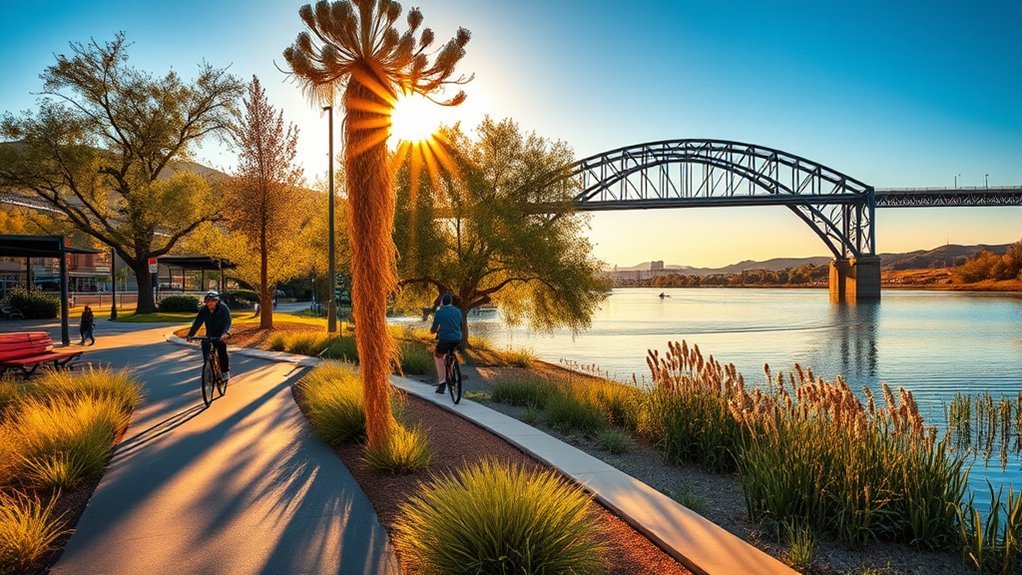
Nestled along the Colorado River, Gateway Park and its riverfront trails offer a peaceful, accessible spot for walking, birdwatching, and catching sweeping water views without leaving town. You’ll find wide, paved paths that suit strollers and bikes, shaded picnic areas, and benches positioned for watching kayakers and seasonal river flows. Interpretive signs point out native plants and explain the river’s role in local history, so you’ll learn as you wander. The riparian habitat attracts herons, egrets, and migratory songbirds; bring binoculars during early morning or late afternoon for the best sightings. Parks staff maintain clean restrooms and potable water, and lighting along main stretches makes evening strolls feel safe. If you want to stretch a workout, the connected trails let you piece together longer loops along the riverfront and into adjacent greenways. Whether you’re after a quiet nature break, family outing, or photo session, Gateway Park delivers accessible outdoor time right in Yuma.
Castle Dome Mines Museum and Ghost Town
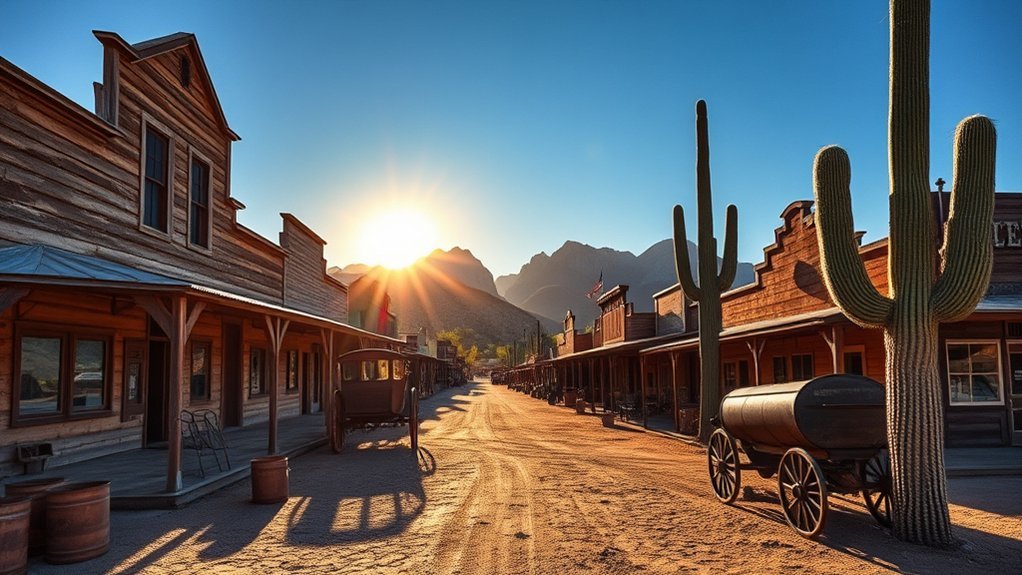
Step back into Arizona’s mining past at Castle Dome Mines Museum and Ghost Town, where restored buildings, original mining equipment, and costumed interpreters bring 19th-century frontier life to vivid, walkable reality. You’ll wander dusty streets, explore a preserved saloon, and peek inside miner cabins that showcase tools, photographs, and the grit of boom-era life. Hands-on exhibits and interpretive signs make history immediate, and occasional demonstrations reveal ore processing and blacksmithing techniques.
- Pan for gold and learn basic prospecting techniques.
- Tour the original general store, schoolhouse, and assay office.
- Inspect vintage mining machinery and restored horse-drawn equipment.
- Photograph rugged desert landscapes framed by historic architecture.
You’ll appreciate the site’s interpretive approach: it’s more than relics — it’s a community reconstruction that honors labor and local stories. Wear comfortable shoes, bring water, and plan for sun; the site sits exposed to desert heat and winds, which only deepens the frontier atmosphere.
Yuma Art Center and Downtown Mural Walk
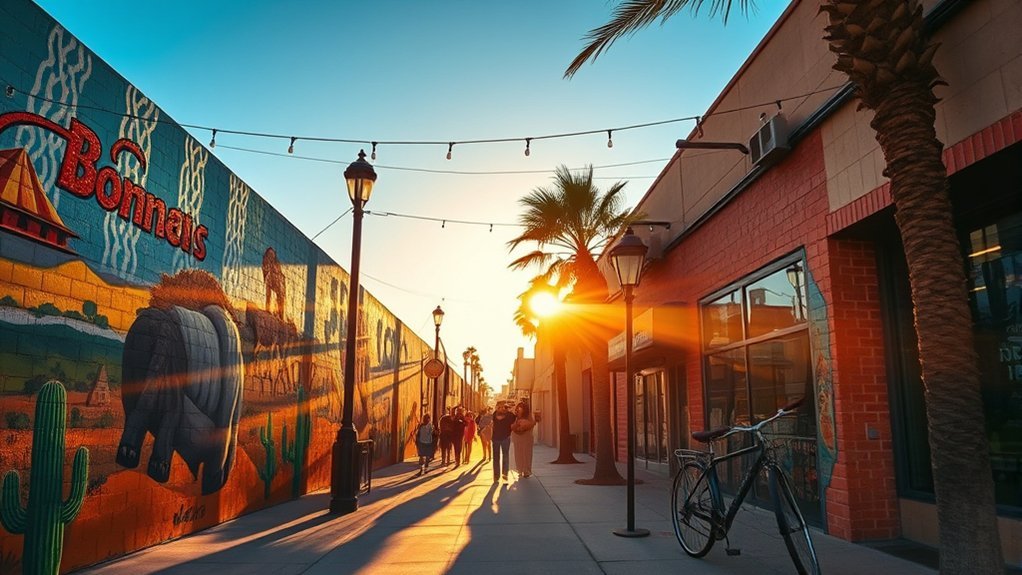
Step into the Yuma Art Center to see rotating exhibits that showcase local and regional artists, then wander downtown to find bold murals that bring the streets to life. You can follow the public art walking map to hit key mural locations and learn about the stories behind each piece. Bring comfortable shoes and your camera—there’s vibrant art around almost every corner.
Yuma Art Center Exhibits
If you’re curious about Yuma’s creative pulse, the Yuma Art Center and its surrounding mural walk deliver vibrant, walkable art experiences. You’ll find rotating gallery shows that spotlight regional painters, sculptors, and mixed-media artists, plus workshops and artist talks that welcome questions and hands-on learning. The center’s galleries change often, so you can return and always see something new.
- Contemporary exhibitions featuring local and Southwest themes
- Interactive workshops for adults and kids
- Curated shows with artist receptions and talks
- Gift shop with prints and handmade goods
You can plan visits around exhibit openings, pick up a brochure at the front desk, and chat with staff about current displays to get the most from each visit.
Downtown Mural Locations
Wander the downtown streets and you’ll find a curated trail of murals that brings Yuma’s stories to life on brick and stucco. You can begin at the Yuma Art Center, where rotating exhibits and community projects spill color onto nearby walls. From there, follow the Downtown Mural Walk to discover portraits of local figures, agricultural scenes, and vibrant abstractions that celebrate the region’s heritage. Each mural includes a small plaque with the artist’s name and inspiration, so you can connect image to intent. Take your time—photograph details, note techniques, and watch how light changes the palette through the day. The route is compact and walkable, making it easy to hop between pieces and grab a coffee at a nearby cafe.
Public Art Walking Map
Start at the Yuma Art Center and let the Public Art Walking Map guide you through a compact, easy-to-follow loop that links the center’s rotating exhibits with the Downtown Mural Walk‘s highlights. You’ll stroll tree-lined streets, spot bold murals, and discover sculptures tucked into plazas. The map pinpoints mural locations, public sculptures, and interpretive signs, so you won’t miss artist statements or historical context. Wear comfortable shoes, bring water, and plan 60–90 minutes to savor details and photo ops. Let the route inspire detours to coffee shops and galleries.
- Follow numbered stops for a logical route
- Read plaques to learn artists’ intent
- Capture photos at golden hour
- Combine the walk with a gallery visit at the Art Center
West Wetlands Park
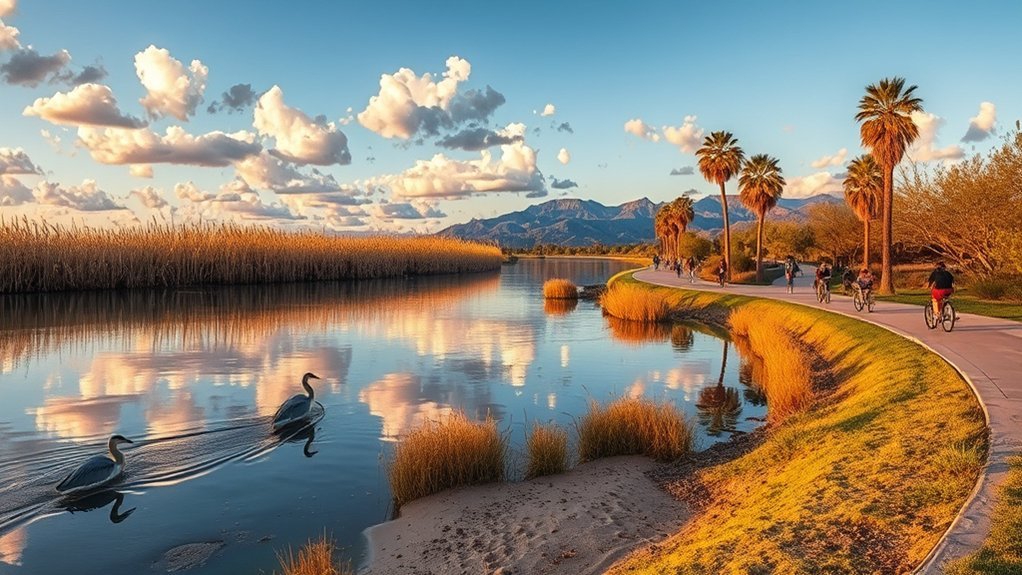
West Wetlands Park offers a peaceful riverside escape where you can walk shaded trails, watch migratory birds, and enjoy river-view picnic spots. You’ll find well-maintained paths that curve through cottonwoods and desert vegetation, making morning jogs and casual strolls equally pleasant. Bring binoculars—the park is a hotspot for migratory species and resident waterfowl along the Colorado River, with interpretive signs that help you identify flora and fauna. Playgrounds and splash pads keep kids entertained, while picnic ramadas with grills let you plan a relaxed afternoon meal. There’s a small amphitheater and open lawns where community events and outdoor fitness classes often happen; check local listings for schedules. Trail surfaces are mostly flat and wheelchair-accessible, and shaded benches appear regularly for rest. If you like photography, golden-hour light on the river provides excellent shots. You can also launch small nonmotorized boats at designated areas, so consider bringing a kayak for a peaceful paddle.
Yuma Palms Regional Center and Shops
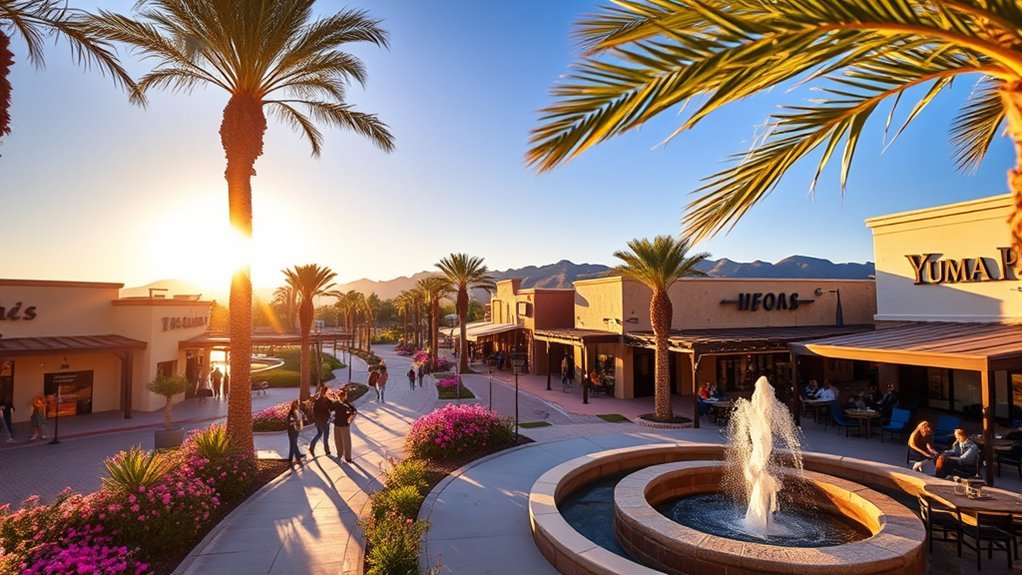
When you head to Yuma Palms Regional Center, you’ll find a wide mix of shops and restaurants where you can grab local flavors or national favorites. The mall also hosts entertainment options like a movie theater and family-friendly spots, plus services ranging from salons to fitness centers. It’s a convenient one-stop area whether you’re shopping, dining, or just looking for things to do.
Shopping and Dining Options
Often overlooked by visitors, Yuma Palms Regional Center is the area’s main shopping and dining hub, where major retailers, local boutiques, and a wide range of restaurants sit within easy walking zones and ample parking. You can stroll between stores, grab a quick bite, or linger over a leisurely meal without hunting for parking. Casual chains sit alongside family-owned cafes, and you’ll find practical shops for outdoor gear, fashion, and gifts. If you’re planning a day of retail therapy or a relaxed evening out, this center delivers convenient variety and familiar comforts.
- Browse national brands for essentials and seasonal deals.
- Discover local boutiques with unique Yuma finds.
- Choose from fast-casual to full-service restaurants.
- Spend a relaxed afternoon people-watching at outdoor seating.
Entertainment and Services
Because Yuma Palms Regional Center combines shopping with entertainment and practical services, you’ll find more than just stores—it’s a convenient one-stop spot for fun and errands. You can catch a movie at the local multiplex, grab a bite at diverse eateries, or pick up essentials at familiar retailers. The mall’s layout makes it easy to move from leisure to logistics, and seasonal events add lively energy.
| Activity | Highlight |
|---|---|
| Movies & arcades | Evening entertainment for families and couples |
| Dining | Choices from quick bites to sit-down restaurants |
| Services & shops | Banks, salons, and everyday retail for errands |
Stroll, shop, or plan a relaxed outing; Yuma Palms helps you maximize time and enjoyment.
M&H Cafe and Sonoran-style Dining Spots
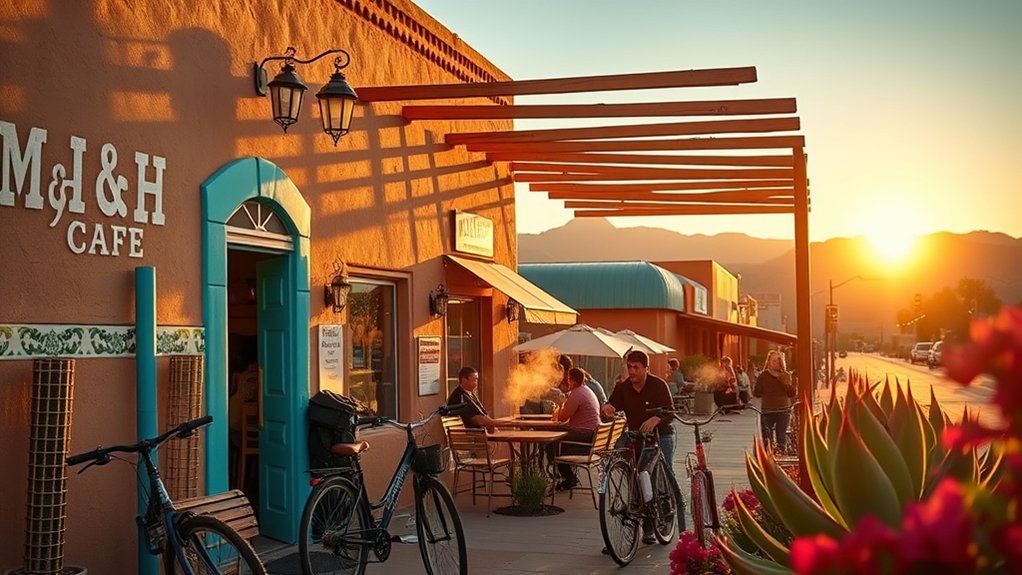
Frequently tucked into local conversations, M&H Cafe serves up classic Sonoran-style breakfast and lunch with a homey, no-frills charm that keeps both locals and visitors coming back. You’ll find hearty huevos rancheros, warm bolillos, and tamales that taste like they were made next door. The atmosphere is casual; servers know regulars by name, and portions are generous.
You can pair your meal with strong coffee or a fresh horchata, then wander nearby streets to discover other Sonoran-style spots where tradition meets bold flavors. Expect grilled meats seasoned simply but perfectly, fresh tortillas, and bright salsa roja that wakes your palate. These places are about honest food, speed, and community — perfect for fueling a day of exploring.
- Try the breakfast plates at M&H for authentic regional flavors
- Order a carne asada burrito at a local taquería
- Sample handmade tortillas while they’re warm
- Ask locals for their favorite hidden gem
Yuma Farmers Market

Head to the Yuma Farmers Market where you’ll find racks of fresh local produce picked that morning and bursting with color. You can chat with growers, sample seasonal treats, and pick up homemade goods for a picnic. Live music and community events give the market a lively atmosphere that makes it a great weekend stop.
Fresh Local Produce
Stroll through the Yuma Farmers Market and you’ll find aisles of vibrant, sun-ripened produce straight from nearby fields—leafy greens, juicy citrus, and heirloom tomatoes that taste like summer. You’ll meet growers who’ll tell you how crops are nurtured in desert soil and why seasonality matters. Pick fragrant herbs, crisp lettuces, and sweet dates, then ask for cooking tips or storage advice to make the most of your haul. Bring a tote and sample the difference fresh makes in flavor and texture. Local produce supports small farms and connects you to the region’s agricultural story.
- Seasonal citrus and dates
- Baby greens and lettuces
- Fresh herbs and microgreens
- Heirloom tomatoes and peppers
Community Events & Music
Often you’ll hear live music drifting through the Yuma Farmers Market, where community events turn a routine shopping trip into a lively weekend gathering. You’ll find local bands, solo acoustic acts, and occasional cultural performances that create a warm, inviting atmosphere as you wander stalls. Seasonal festivals, cooking demos, and kids’ activities pop up throughout the year, so check the market calendar before you go. You can sample regional flavors while listening to storytellers or joining a dance circle, and friendly vendors often share the backstory behind heirloom produce or handmade crafts. The market’s communal vibe makes it easy to meet neighbors, discover hidden gems, and plan return visits when special themed events bring even more color and sound.
Spring Mountain Ranch Preserve
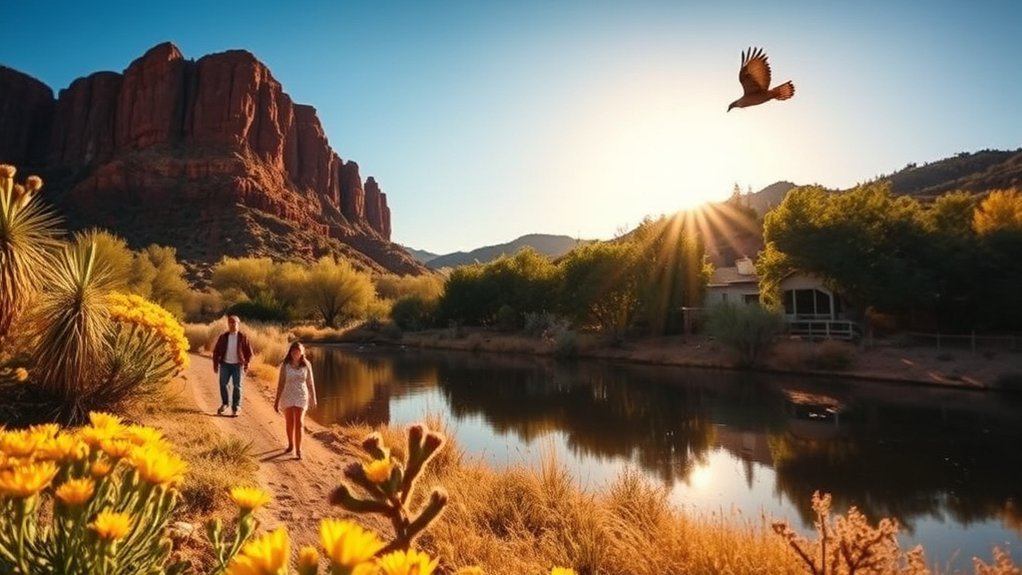
Spring Mountain Ranch Preserve offers a peaceful escape where you can explore restored wetlands, cottonwood groves, and looping trails that trace the property’s ranching past. You’ll find quiet ponds that attract birds, shady trees that break the desert sun, and interpretive signs that reveal the landscape’s history and ecology. The terrain is gentle, so you can wander at your own pace, photograph wildlife, or sit on a bench and listen to rippling water.
- Walk the main loop to spot migratory birds and native plants.
- Follow side paths to discover old ranch features and interpretive panels.
- Bring binoculars for waterfowl and raptor viewing in the wetlands.
- Pack water and sun protection; trails are exposed in midday.
You won’t need strenuous effort to enjoy varied habitats and seasonal blooms. Spring Mountain Ranch preserves a quieter, natural side of Yuma where you can learn about conservation, enjoy accessible trails, and recharge away from the city bustle.
Yuma Quartermaster Depot State Historic Park
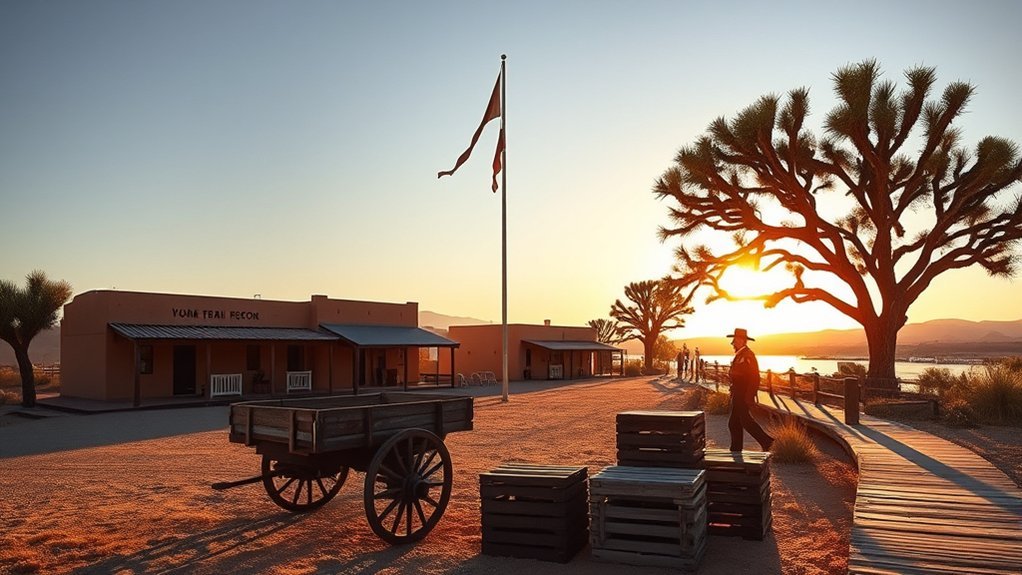
You can explore the Yuma Quartermaster Depot State Historic Park to see where the Army managed supplies across the Southwest. The park preserves several 19th-century buildings, from warehouses to officers’ quarters, that give a clear sense of military logistics in that era. Staff and volunteers often run living-history demonstrations, so you’ll get hands-on looks at daily life and equipment from the period.
Historic Military Supply Hub
Step into the Yuma Quartermaster Depot State Historic Park and you’ll find the well-preserved heart of the 19th-century military supply network that kept frontier forts and river traffic running. You’ll trace how provisions, ammunition, and equipment funneled through this logistical hub, shaping regional security and settlement. As you explore, imagine steamboats and wagons unloading essential cargo while clerks and quartermasters coordinated shipments.
- Follow interpretive displays that explain supply routes and military strategy.
- See artifacts illustrating how goods were stored, inventoried, and dispatched.
- Learn about the depot’s role in Navajo and Apache campaigns and territorial expansion.
- Join guided tours that place the depot in the broader story of western logistics.
The site makes logistics feel immediate, practical, and historically significant.
Preserved 19th-Century Buildings
While you wander the Yuma Quartermaster Depot State Historic Park, the row of adobe and California-style buildings instantly anchors you in the 1870s—storehouses, offices, and workshops that still show the scars and details of frontier military life. You can trace original adobe walls, heavy timber beams, and wide plank floors that reveal construction techniques adapted to desert heat. Interpretive plaques point out features like iron hardware, ventilation ports, and patched adobe where repairs tell stories of decades of use. The site’s compact layout helps you visualize supply flows from riverboat to wagon. Photogenic and quietly powerful, these preserved structures give you a tangible link to military logistics, regional commerce, and everyday routines of soldiers and civilians on the frontier.
Living-History Demonstrations
When costumed interpreters bring the Quartermaster Depot to life, you’ll see everyday 19th‑century routines—gear packing, mule handling, and period cooking—performed with hands‑on detail and historical context. You’ll wander between adobe buildings, listening as guides explain supply chains, military logistics, and civilian life along the Colorado River. Sensory details—clanking tools, leather smells, wood smoke—make history tangible. Expect interactive moments where you can try on kit, help roll canvas, or grind corn under supervision. Demonstrations change seasonally, so check the schedule.
- Watch mule team demonstrations and learn tack techniques
- Observe authentic food preparation over open flame
- Handle reproduction equipment and ask living historians questions
- Join scheduled talks on depot operations and regional impact
Ocean-to-Ocean Bridge
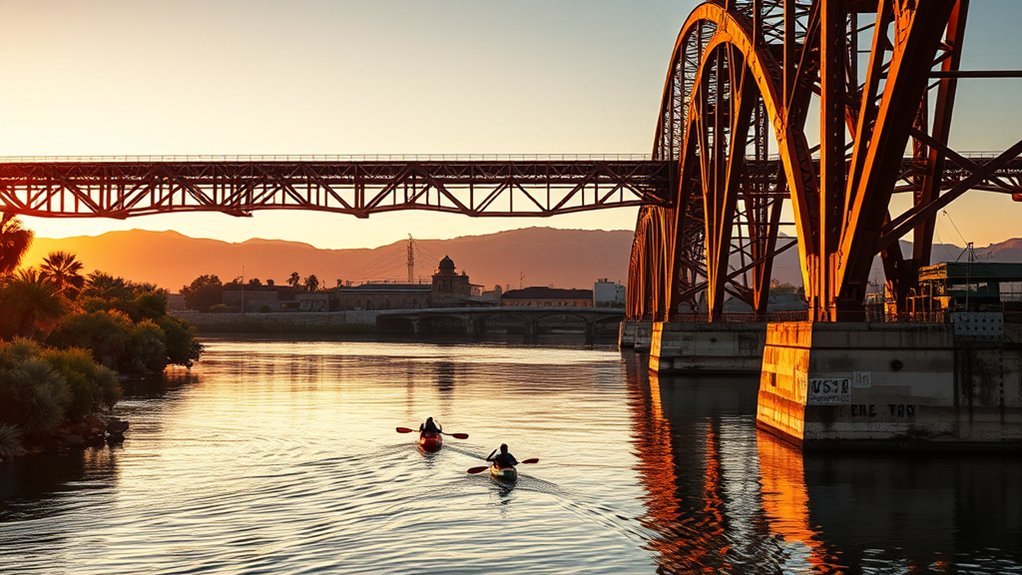
Perched over the Colorado River like a slice of history, the Ocean-to-Ocean Bridge invites you to cross a century-old engineering landmark and take in Yuma’s riverfront from a new angle. You’ll notice its steel trusses and concrete piers, restored to preserve the 1915 design that once linked coasts. Walk or ride across; the bridge is pedestrian-friendly and gives you framed views of river channels, sandbars and distant desert ridgelines. Informational plaques along the span explain construction methods, historic travel routes and the bridge’s role in regional growth, so you’ll learn as you move. Photographers love the symmetry of ironwork against sunrise and sunset light, while history buffs will appreciate maintenance details highlighting preservation choices. Parking and access are simple from downtown Yuma, making it an easy stop between museums and cafés. Whether you pause for a few minutes or linger to watch river life, the bridge offers a compact, tangible connection to Yuma’s past and ongoing river story.
Yuma East Wetlands and Observatory
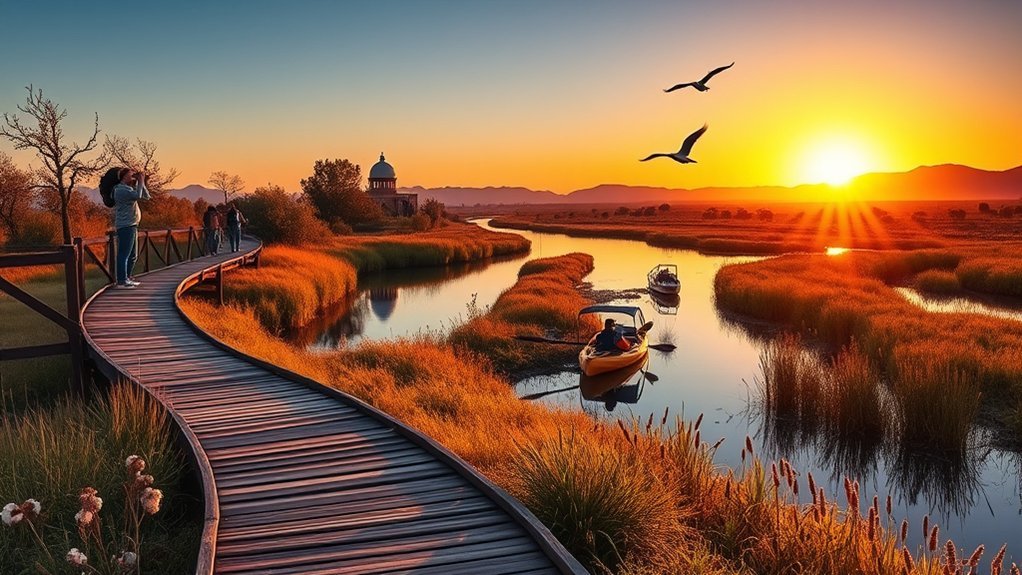
At Yuma East Wetlands and Observatory you’ll spot marsh wildlife along winding trails that bring you close to native plants and quiet viewing platforms. Come at dusk for the observatory’s stargazing nights, where telescopes and knowledgeable volunteers point out planets and constellations. Bring binoculars for excellent birdwatching—seasonal migrations make the wetlands a top stop for both casual and serious birders.
Wetland Wildlife Viewing
Often you’ll find the Yuma East Wetlands quietly humming with life, a surprising oasis where riparian plants, migratory birds, and native desert species converge. You’ll stroll narrow boardwalks and spot herons, egrets, and warblers flitting through reeds, while marsh wrens click and dragonflies hunt over still water. Bring binoculars, stay low and slow, and you’ll catch flash moments: a kingfisher dive, a turtle sunning on a log, marsh grasses rippling in a warm breeze. Look for seasonal visitors during migration and resident species year-round. Helpful tips:
- Pack field guide or app for quick ID of birds and plants
- Visit early morning for peak activity
- Respect habitat: stay on trails, keep dogs leashed
- Carry water and sun protection
Observatory Stargazing Nights
After a day spotting marsh wrens and kingfishers, the wetlands take on a different magic at night when the Yuma East Observatory opens its doors for stargazing nights. You’ll step from quiet marsh paths into a clear desert sky, where volunteers and staff guide you to telescopes aimed at planets, star clusters, and distant galaxies. They’ll explain what you’re seeing, point out constellations, and offer binoculars for closer views. Programs often include themed talks, live demonstrations, and opportunities to photograph the sky. Dress for cooler evenings, arrive early to learn the layout, and bring a red flashlight to preserve night vision. Whether you’re a curious beginner or a budding astronomer, the observatory makes the cosmos accessible and memorable.
Birdwatching and Trails
While the observatory draws sky-watchers, the Yuma East Wetlands lure birders with winding trails that put you inches from marshes, cottonwoods, and the flitting shapes of warblers and herons. You’ll follow boardwalks and dirt paths that reveal seasonal migrants, resident waterfowl, and raptor thermals over the river. Bring binoculars, a field guide, and water; mornings are best for activity and softer light. Interpretive signs explain habitat restoration and species to watch for, and volunteers can point out secretive species.
- Best times: dawn and early morning
- What to bring: binoculars, hat, water, camera
- Look for: egrets, kingfishers, warblers, raptors
- Accessibility: paved loops and short boardwalks for easy viewing
Kofa National Wildlife Refuge
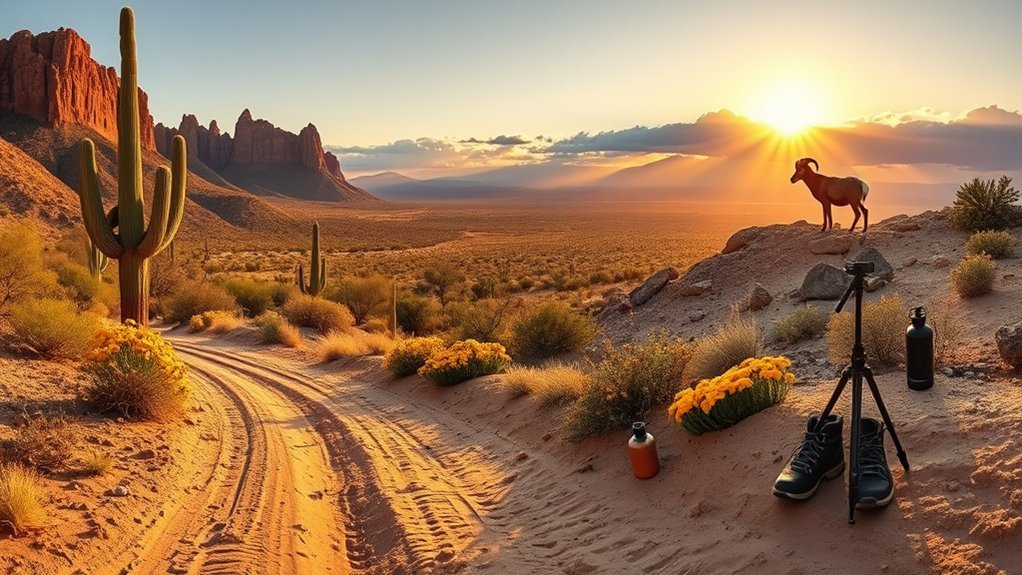
Step into the rugged heart of southwestern Arizona at Kofa National Wildlife Refuge, where jagged mountains, vast desert plains, and seasonal washes create a dramatic backdrop for wildlife viewing and solitude. You’ll find sprawling creosote flats broken by volcanic spires and the iconic Kofa Mountains, offering vivid scenery and stark contrasts at sunrise and sunset. Trails range from short interpretive walks to challenging backcountry routes that reward you with panoramic views and rare desert flora like ocotillo and brittlebush. Keep your eyes peeled for desert bighorn sheep traversing steep ledges, as well as coyotes, Gila monsters, and a surprising variety of birds. Bring plenty of water, sun protection, a detailed map, and a high-clearance vehicle for some access roads. Camping is primitive—no hookups—so plan accordingly. Because it’s a protected refuge, respect seasonal closures and leave no trace. Kofa delivers solitude, striking geology, and authentic Sonoran Desert experiences away from the crowds.
Mittry Lake Wildlife Area
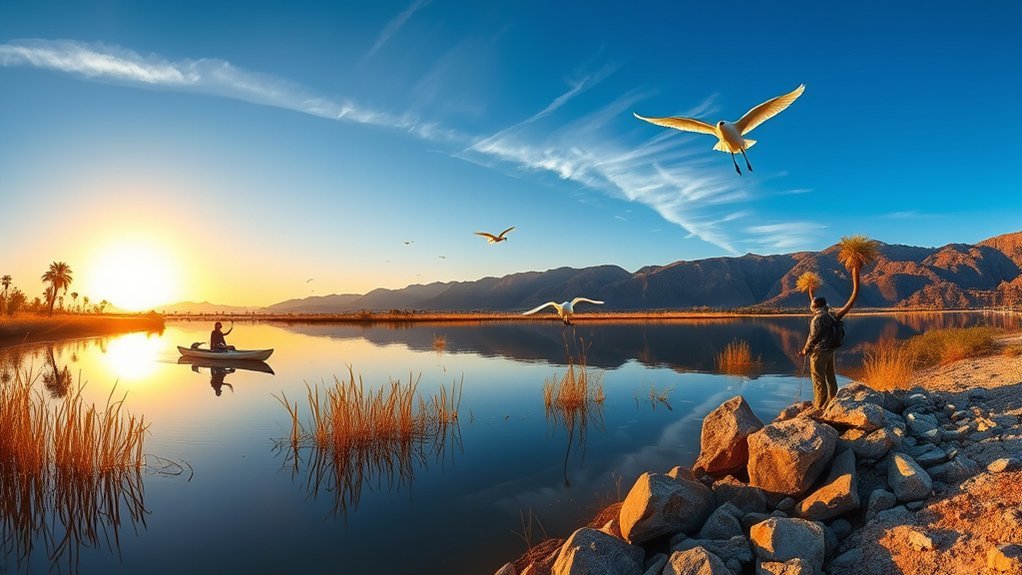
Nestled along the lower Colorado River, Mittry Lake Wildlife Area offers calm waters, marshy shorelines, and easy access for anglers, birders, and families looking for a quiet outdoor escape. You’ll find shallow coves and cattail-fringed banks where bass, catfish, and sunfish keenly await to bite, and small launch sites make paddling or bank fishing simple. The area’s wetlands attract waders, waterfowl, and migratory songbirds, so bring binoculars and a field guide. Trails and picnic spots let you linger as the light changes over the reeds.
- Launch a kayak or canoe into protected backwaters for close wildlife views.
- Cast a line from shore or a small boat—habitat supports steady catches.
- Stroll short trails to watch herons, egrets, and seasonal migrants.
- Pack a picnic and enjoy quiet sunset reflections over the lake.
Facilities are basic, so come prepared with water, sun protection, and respect for habitat and nesting areas.
Gila River Outpost and Birding Sites
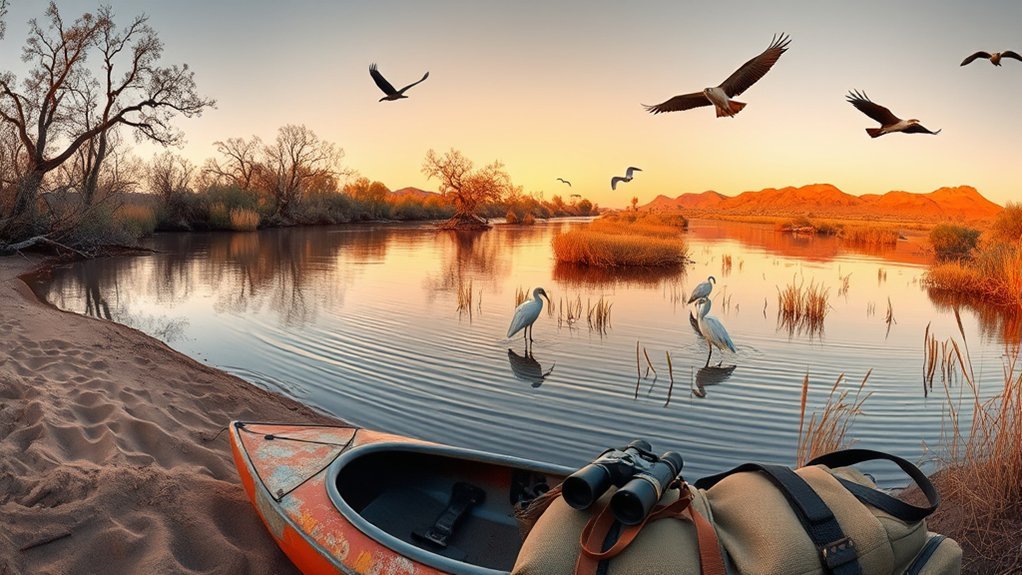
Following the river’s bends, the Gila River Outpost and nearby birding sites put you right where marshy channels, cottonwood galleries, and open water meet—prime habitat for kingfishers, herons, and migrating warblers. You’ll find short trails, observation blinds, and interpretive signs that make spotting and identifying species easy, even if you’re new to birding. Bring binoculars and a field guide; early morning light reveals Rufous-crowned Sparrows, Black-crowned Night-Herons, and occasional raptors riding thermal currents. The outpost offers maps and local tips about seasonal highlights and the quieter spots for kingfishers diving from low branches. Photo opportunities abound along the riverbanks and shaded pullouts, where you can watch waterfowl dabble and listen to canopy chatter. Respect posted regulations, stay on designated paths to protect nesting areas, and pack water—summer heat can be intense. Whether you want a relaxed stroll or a focused species list, this stretch of the Gila delivers rewarding, accessible birding close to Yuma.
Painted Cave and Desert Rock Formations
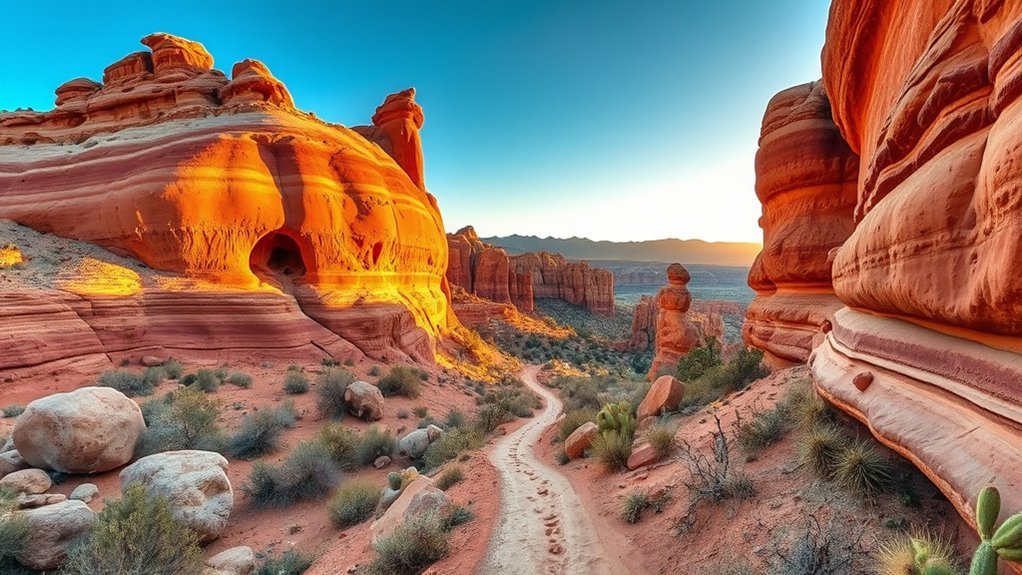
A short scramble from the trailhead brings you to the Painted Cave, where wind-polished sandstone and ochre-streaked cliffs create a natural gallery of swirls, fossils, and mineral veins that seem to glow at golden hour. You’ll find narrow alcoves and broad overlooks that reward slow exploration; the textures and colors change as sunlight tilts across banded layers. Listen for soft echoes and watch for small lizards slipping between crevices.
A short scramble leads to Painted Cave’s wind-polished sandstone and ochre cliffs—swirls, fossils, and soft echoes at golden hour
- Bring sturdy shoes and plenty of water for uneven footing and sun exposure.
- Carry a camera or sketchbook to capture patterns, but don’t disturb fragile rock art or fossils.
- Visit late afternoon for the best light and cooler temperatures.
- Stay on established paths to protect cryptobiotic soil and native plants.
These formations tell a geological story of shifting seas and desert winds; when you pause and read the layers, you’ll leave with a clearer sense of deep time and a handful of striking images.
Yuma Proving Ground Historic Sites
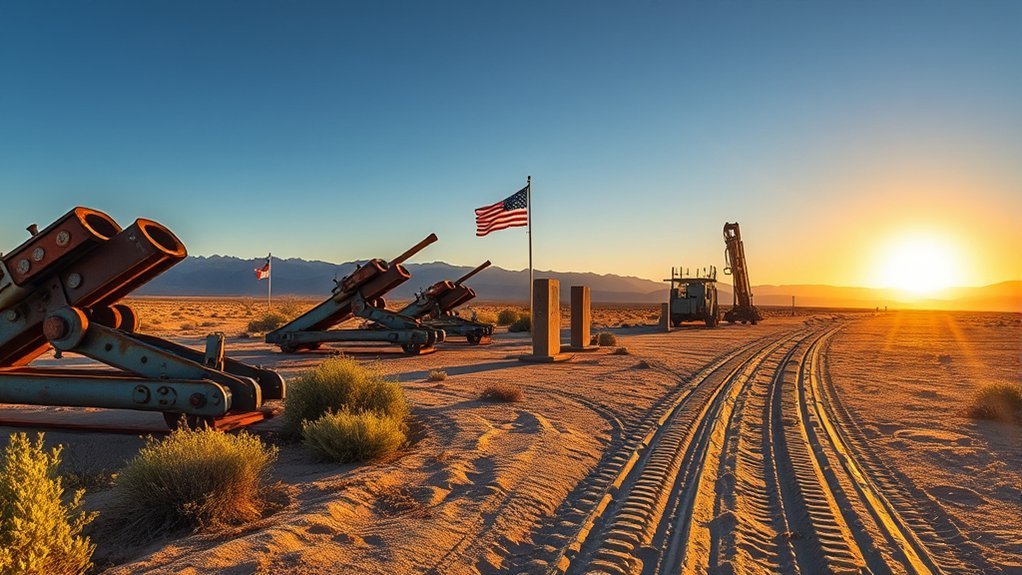
When you explore the Yuma Proving Ground historic sites, you’ll find a surprising mix of military history, desert engineering, and preserved buildings that trace the area’s role from World War II through modern testing. You can walk among concrete bunkers, observation towers, and the remains of airfields that once supported vehicle and ordnance trials. Interpretive signs explain how harsh desert conditions shaped weapons development and soldier training, and you’ll appreciate the scale of long-range test tracks carved into the landscape. Photography lovers will enjoy stark lines and weathered textures against bright sky. Access is limited in places for safety and security, so check visitor requirements and guided-tour opportunities before you go. Bring water, sun protection, and a keen sense of curiosity; the site rewards those who look closely at utilitarian architecture and logistics infrastructure. This is a chance to connect with a focused chapter of American military and engineering history that’s uniquely Yuma.
Yuma Brewing Company and Local Taprooms
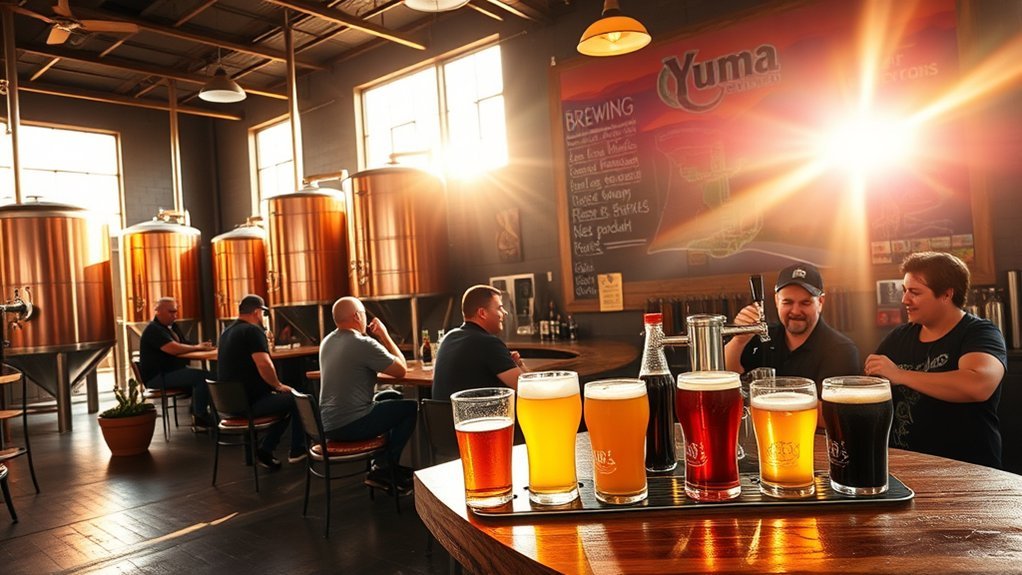
While you’re exploring Yuma’s downtown scene, don’t miss Yuma Brewing Company and the cluster of taprooms nearby, where local brewers blend Sonoran flavors with classic craft techniques. You’ll find a lively, friendly atmosphere—tasting flights that highlight citrusy, cactus-forward ales, malty staples, and seasonal small-batch experiments. Staff are keen to explain pairings with local bites, and outdoor patios make sampling comfortable year-round.
- Try a flight to compare flagship brews and rotating taps.
- Ask about house-made salsas or snacks that complement hop profiles.
- Visit during a brewery event or trivia night to meet locals and brewers.
- Pick up growlers or packaged beers to enjoy later or share as gifts.
Wander between taprooms on foot; each spot has its own vibe, from industrial-chic to cozy taproom. You’ll leave with a better sense of Yuma’s craft scene and a few favorites to remember.
Desert Sunsets at Martinez Lake
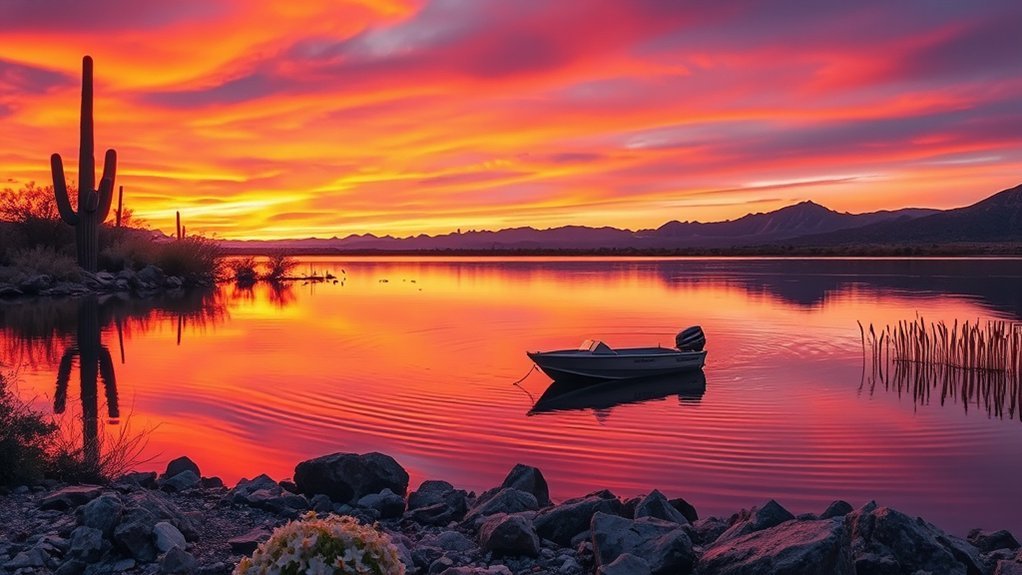
After you’ve sampled Yuma’s taprooms and picked up a growler, head west toward Martinez Lake for one of the region’s most memorable sunsets. You’ll find a low, open shoreline where the Colorado’s backwaters widen into glassy pools that mirror a sky gone molten. Arrive early to stake a spot on sandy banks or a pull-out bluff; light fades fast, and the color show evolves from gold to coral to indigo in minutes. Bring a light jacket—the desert cools quickly—and a folding chair or blanket for comfort. If you’re into photography, use a wide lens to capture the lake’s reflective foreground and the long, horizontal cloud bands. Binoculars reveal shorebirds settling in reed beds while distant hills silhouette against the glow. There are picnic tables and informal launch points for kayaks if you want to linger after dusk. Respect private property and pack out your trash so this tranquil scene stays pristine for the next visitor.
Off-Road Tours and ATV Excursions
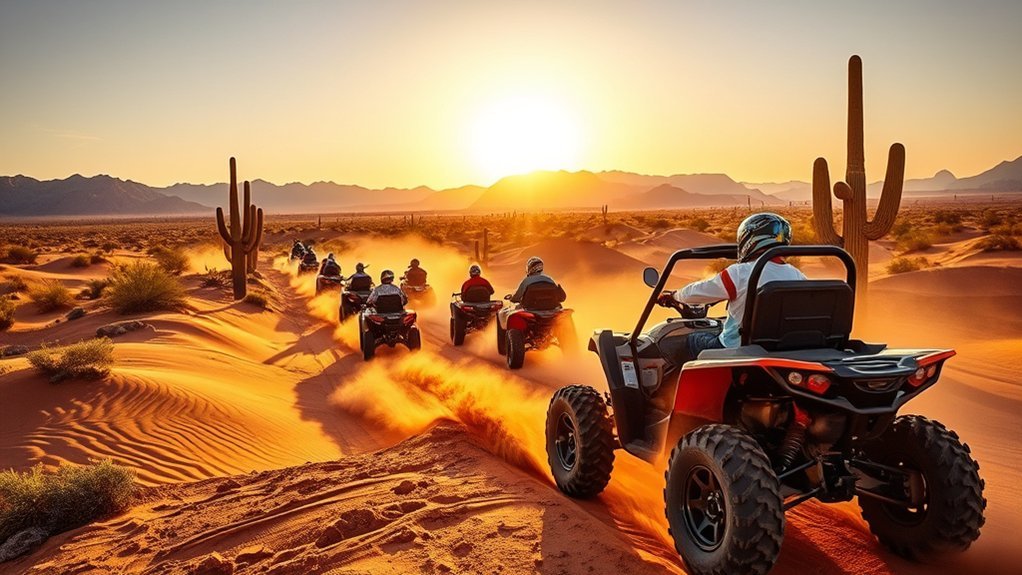
Kick up dust and feel the desert pulse on an off-road tour or ATV excursion that puts you in the driver’s seat of Yuma’s rugged landscapes. You’ll navigate sandy washes, rocky mesas, and wide-open river flats while guides point out desert plants, wildlife, and historic mining sites. Tours vary from adrenaline-filled dune runs to scenic sunset rides, so pick one that matches your pace and skill. Operators provide safety gear and briefing, but you’ll still want sunscreen, closed-toe shoes, and plenty of water. Expect photography stops where the light turns the terrain molten gold.
Kick up desert dust on guided ATV tours—dune runs, sunset rides, and rugged landscapes primed for golden-hour photos.
- Guided tours with experienced local guides who know the best routes
- Single- and two-seat ATVs, UTVs, and side-by-sides for different comfort levels
- Half-day and full-day options, including sunrise or sunset departures
- Terrain-specific rides: sand dunes, rocky trails, and river-adjacent flats
These excursions deliver a hands-on way to experience Yuma’s wild side, whether you crave speed, scenery, or both.
Annual Yuma Lettuce Days and Local Festivals
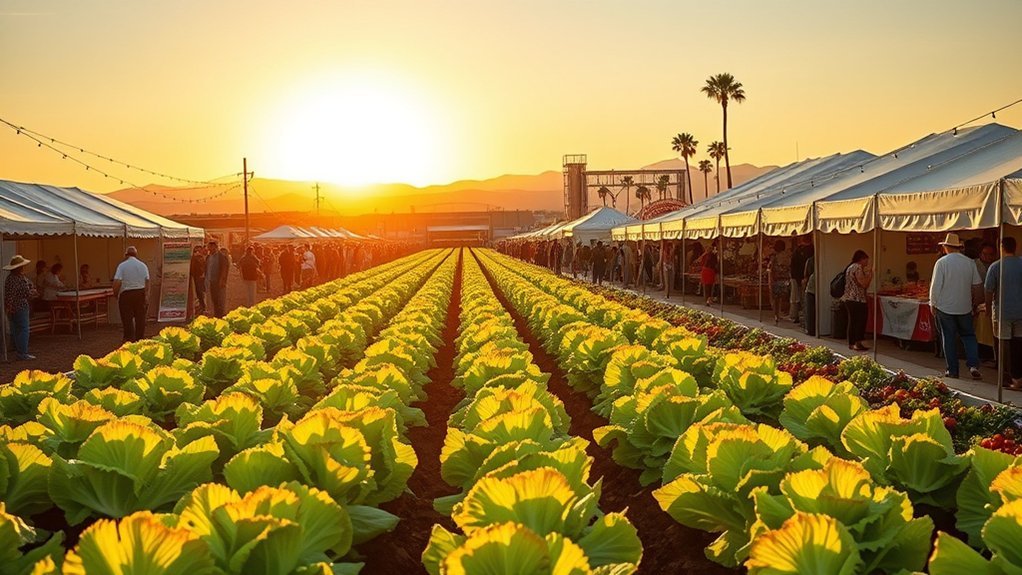
Often held each spring, Yuma Lettuce Days bursts into town with a celebration of the region’s agricultural roots and community spirit. You’ll wander stalls selling crisp, locally grown produce, sample inventive lettuce-based dishes from food trucks, and watch cooking demos that show how desert farming yields flavorful results. Live music and family-friendly activities keep energy high while informational booths share sustainable farming practices and water-conservation efforts crucial to the valley.
Beyond Lettuce Days, Yuma’s festival calendar offers seasonal fairs, cultural celebrations, and nightlife-packed events that spotlight local artists and historic downtown venues. You can join parades, craft markets, and heritage events that connect you to the community’s diverse influences—Native American, Mexican, and early American settlers. Check local listings for dates, ticket details, and volunteer opportunities, because attending these festivals gives you more than entertainment: it helps support the farms and organizations that sustain Yuma’s character year-round.
Frequently Asked Questions
What Is the Best Time of Year to Visit Yuma for Mild Weather?
Late fall through spring is best for mild weather; you’ll enjoy comfortable daytime highs, cooler nights, and minimal extreme heat. Plan between November and April, when outdoor activities are pleasant and sunshine still lights up the desert.
Are There Guided Day Trips to Nearby Mexican Border Towns?
Absolutely — you’ll find guided day trips to nearby Mexican border towns, offering immersive cultural tours, food tastings, and historic sites. They’re immensely popular, so book early; check schedules, border requirements, and guided crossing details.
Where Can I Find Lodging With River Views Near Downtown Yuma?
You’ll find river-view lodging near downtown Yuma along the Colorado River waterfront—check hotels and boutique inns on Main Street, West 4th Avenue, and near the Gateway Park area; book rooms with balcony or river-facing suites in advance.
Is Yuma Family-Friendly With Activities for Young Children?
Yes—you’ll find Yuma very family-friendly; it’s like a shaded park where toddlers chase butterflies: you’ll enjoy splash pads, children’s museums, easy nature trails, riverboat rides, and parks with playgrounds that keep little ones busy and happy.
How Accessible Are Attractions for Visitors With Mobility Limitations?
Most attractions are fairly accessible, and you’ll find ramps, paved paths, and accessible restrooms at museums, parks, and riverfront areas. You’ll want to call ahead for specific accessibility features and ADA-compliant parking or services.
Conclusion
You’ve seen why Yuma’s a surprising playground—from dusty ghost towns to riverfront birding—so go make your own memories. Fun fact: Yuma averages more than 350 sunny days a year, so almost any outdoor plan will work. Whether you’re tracing frontier history at the Territorial Prison, chasing dunes on an ATV, paddling the Colorado, or savoring Sonoran breakfast, you’ll find photo ops, guided programs, and plenty of local flavor waiting for you.

